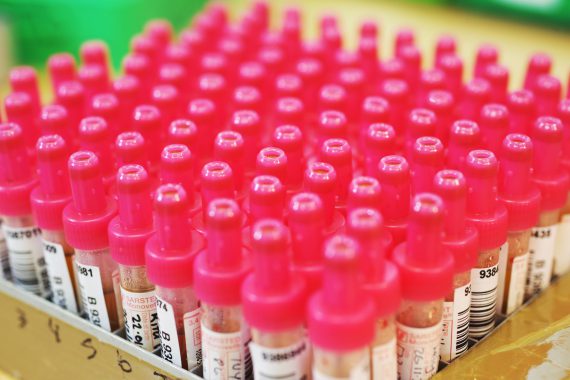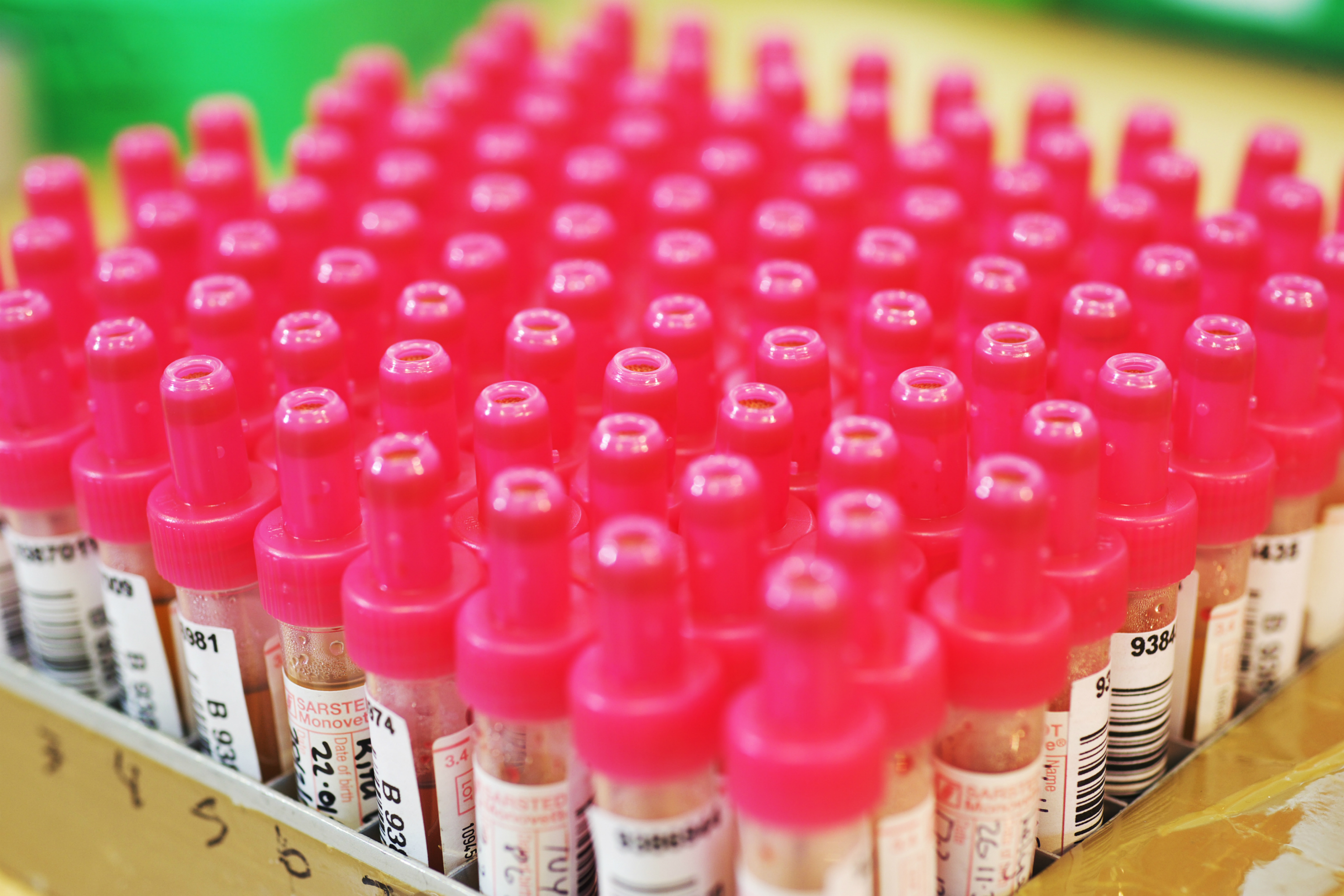Six o’clock blood result: hyperkalaemia


Control of plasma potassium concentration
The plasma potassium concentration (usually 3-5-5.0mmol/L) is a poor indicator of the total body content, as the total amount of potassium in the body is about 3000mmol, yet about 98% is intracellular. Severe hyperkalaemia can be defined as serum potassium concentration of more than 6.5mmol/l, with greater than 7mmol/l deemed immediately life threatening.
Potassium is principally absorbed in the small intestine. Fruit and vegetables are usually ‘rich’ in potassium, for example bananas contain about 6mmol per 100g. A total of about 60mmol/day is lost into the intestinal lumen, most of which is reabsorbed.
Potassium is normally almost completely reabsorbed in the renal proximal tubules and is secreted in the distal tubules and collecting ducts in exchange for sodium; hydrogen ions compete with potassium ions. The mineralocorticoid hormone aldosterone stimulates both exchange mechanisms.
The ATPase on cell surfaces maintains a high intracellular potassium concentration. A small movement of potassium ions out of cells may cause a significant rise in plasma concentrations, whether in vivo or in vitro. Increased release and net loss of potassium by cells may occur in acidosis. Insulin enhances the cellular uptake of both glucose and potassium. Beta-adrenergic stimulation increases cellular potassium ion uptake by activating the ATPase.
Pseudohyperkalaemia
Pseudohyperkalaemia can be defined as elevation in the serum or plasma potassium concentration above the reference range that occurs either due to transcellular movement of potassium ions out of cells, during or after phlebotomy, or is the result of contamination of blood sample with potassium containing substances. Pseudohyperkalaemia may occur with delays in sample separation of the plasma from the cells. This is particularly likely if the blood sample has been refrigerated or presence of if exposed to cold ambient temperatures, when the activity of the sodum/potassium ATPase pump is slowed. Leucocytosis and thrombocytosis can also cause pseudohyperkalaemia when leakage of potassium from the large cell mass occurs.
Potassium-EDTA (ethylenediamine tetra-acetic acid) contaminated blood tubes can also cause pseudohyperkalaemia. Blood samples for potassium assay should usually be collected in lithium heparin tubes. With indwelling needle devices for phlebotomy, the tube for plasma or serum potassium should be collected before any tubes containing potassium-EDTA so as to avoid needle contamination. As a practical example, this means that the tube for U&Es should be filled before the tube for an FBC. A rare familial form of pseudohyperkalaemia is thought to be due to ‘defective’ red cell membranes. See box, below.
Some causes of pseudohyperkalaemia
Haemolysis
Leucocytosis or thrombocytosis
Delayed sample separation
Sample kept in cold ambient environment
Potassium contaminated sample, for example, EDTA tube
Intravenous drip arm sample
Repeated patient fist clenching during phlebotomy
Rare familial forms
Causes of hyperkalaemia
In broad terms, the causes of hyperkalaemia are increased body intake of potassium, reduced potassium excretion by the kidneys, reduction in mineralocorticoid activity and movement of potassium out of cells such as an acidosis. Many causes are iatrogenic and involve medications known to raise plasma potassium.
Renal causes of hyperkalaemia
– Acute kidney injury (AKI) or chronic kidney disease (CKD) are commonly associated with hyperkalaemia. The kidney is the major excretor of potassium accounting for about 90% of total excretion.
– Mineralocorticoid hormones, mainly aldosterone, have a renal sodium-retaining and potassium-losing action, and so deficiency of these hormones can cause hyperkalaemia. Such conditions include the following:
o Adrenal insufficiency (Addison’s disease)
o Hyporeninaemic hypoaldosteronism. This usually presents in the elderly, often with renal impairment and type 2 diabetes and is associated with hyperkalaemia and type IV renal tubular acidosis
o Congenital adrenal hyperplasia (CAH) such as C21-hydroxylase deficiency (rare)
o Pseudohypoaldosteronism, such as Gordon’s syndrome (very rare). This is a familial renal tubular defect characterised by hypertension and hyperkalaemic metabolic acidosis in the presence of low plasma renin and aldosterone levels.
– Drugs affecting renal function or the mineralocorticoid system such as ACE inhibitors, spironolactone, potassium-sparing diuretics, ARBs, heparin, NSAIDs, ciclosporin, tacrolimus, pentamidine, co-trimoxazole, ketoconazole and metyrapone,
Non-renal causes of hyperkalaemia
– Excessive intake of potassium by the body, orally via the intestine or IV. This may occur especially in patients with impaired renal function.
– Redistribution of potassium ions out of cells.
– Acidosis, severe tissue damage (for example, haemolysis), burns, crush injury, tumour lysis syndrome, rhabdomyolysis, hypoxia and severe exercise. In these cases intracellular potassium moves out of cells into the vascular compartment.
– Familial hyperkalaemic periodic paralysis is exceedingly rare and is associated with release of potassium from cells. It is an inheritedautosomaldominant disorder with defective sodium channels in muscle cells (SCN4A).
– Various drugs, such as digoxin, beta-blockers and succinylcholine, can cause hyperkalaemia by reducing the entry of potassium into cells. See box below.
Some causes of hyperkalaemia
Increased intake
Dietary source
Intravenous/oral potassium
Renal impairment
Renal glomerular dysfunction (such as acute or chronic renal disease)
Mineralocorticoid deficiency
Hypoaldosteronism (Addison’s disease)
Hyporeninaemic hypoaldosteronism (type IV renal tubular acidosis)
Congenital adrenal hyperplasia (21-hydroxylase deficiency)
Pseudohypoaldosteronism, such as Gordon’s syndrome
Tissue redistribution of potassium; intracellular to extracellular shift
Hypoxia
Acidosis
Rhabdomyolysis
Severe tissue breakdown, such as crush injury
Tumour lysis syndrome
Familial hyperkalaemic periodic paralysis
Drugs
ACE inhibitors
Spironolactone
Potassium-sparing diuretics
ARBs
Digoxin
Beta-blockers
Succinylcholine
Heparin
NSAIDs
Ciclosporin
Tacrolimus
Pentamidine
Co-trimoxazole
Ketoconazole
Metyrapone
Clinical features of hyperkalaemia
Severe hyperkalaemia carries the danger of cardiac arrest and death. Changes are also seen on ECG, such as widening of the QRS complex and tall, ‘tented’ T waves. Muscle weakness, paralysis and seizures can also occur. However, the patient may be asymptomatic. See box below.
Some clinical features of hyperkalaemia
Cardiac arrest
ECG changes, such as widening of the QRS complex and tall, ‘tented’ T waves
Respiratory muscle weakness
Muscle weakness and flaccid paralysis
Depressed or absent tendon reflexes
Acidosis
Investigation of hyperkalaemia
– It is important to first exclude artefactual or spurious (pseudohyperkalaemia), see table 1 above.
– A drug history is essential – are there hyperkalaemic-inducing medications?
– What is the renal function? Look at the eGFR, is there urinary retention? Severe renal dysfunction is a common cause of hyperkalaemia.
– Looks for causes, usually obvious, for cell damage or transcellular potassium shifts, such as hypoxia, rhabdomyolysis or severe trauma.
– Look for evidence of adrenal insufficiency, which can be life threatening. If there is any doubt, consider an endocrine opinion and a short Synacthen test.
– Exclude an acidosis; measure the plasma bicarbonate concentration. In a metabolic acidosis, a low plasma bicarbonate is observed. This can cause hyperkalaemia even if the glomerular function is normal.
The trans-tubular potassium gradient (TTKG) is a measure of assessing renal potassium secretion by the cortical collecting duct, indirectly assessing mineralocorticoid activity in patients who have hyperkalaemia. Reference range for TTKG on a normal diet is 8-9. Low TTKG levels (<7) during hyperkalaemia suggest mineralocorticoid deficiency or an inappropriate renal response to hyperkalaemia. In hyperkalaemia due to high potassium intake, more potassium should be excreted in the urine and the TTKG should then be above 10.
The TTKG test requires a spot urine sample taken for osmolality and potassium, at the time of the blood test for plasma osmolality and plasma potassium. The formula for calculating the TTKG =
Urine [potassium] / urine osmolality
_______________ _______________
Plasma [potassium] Plasma osmolality
Consider rare causes of hyperkalaemia, such as hyporeninaemic hypoaldosteronism, pseudohypoaldosteronism and type IV renal tubular acidosis. Here, plasma aldosterone and renin levels may be useful, and in the case of type IV renal tubular acidosis, a hyperchloraemic acidosis (low plasma bicarbonate and raised chloride concentration or normal anion gap acidosis) may be present and a urine pH that fails to acidify in the presence of an acidosis.
Treatment of hyperkalaemia
Immediate treatment
Emergency treatment is necessary when plasma potassium is more than 7.0mmol/l or with significant ECG changes (although severe hyperkalaemia can occur in the presence of normal ECG) or symptoms present.
Stop any potassium-containing medications or drugs that retain potassium. Calcium gluconate or chloride, 10ml of a 10% solution, can be given slowly over a few minutes intravenously with ECG monitoring. If there is no improvement then give 10ml every 10 minutes until the ECG normalises (it could require up to 50ml). This does not alter potassium concentrations but does antagonise the effect of hyperkalaemia upon cardiac muscle. Calcium should never be added to bicarbonate solutions because calcium carbonate can precipitate out. If too much calcium is given, hypercalcaemia may cause cardiac arrest. Seek expert advice if the patient is on digoxin.
Intravenous 50ml glucose 50% solution with 10 units of soluble insulin by intravenous injection over 15 to 30 minutes starts to lower plasma potassium concentrations for a couple of hours by increasing potassium entry into cells, but look out for hypoglycaemia. Seek expert advice if an acidosis present.
In addition, 10-20mg nebulised salbutamol can be used to treat hyperkalaemia by redistribution of potassium into cells in about 30 minutes, lasting a couple of hours, and with a reduction in plasma potassium by about 0.50-1.0mmol/l. In severe hyperkalaemia, particularly with renal dysfunction, haemofiltration or dialysis may be indicated.
Long-term treatment of chronic hyperkalaemia
Sodium or calcium polystyrene sulphonate 15g orally three or four times a day can remove potassium from the body, but may take at least a day to manifest. Remember to review the patient’s renal function and medications that may raise plasma potassium. Treating some of the causes of hyperkalaemia summarised in the table above may also help reduce the plasma potassium concentration.
Key points – treating hyperkalaemia
If life threatening, intravenous calcium gluconate or chloride followed by insulin/glucose infusion
Salbutamol nebuliser
Dialysis or haemofiltration if refractory
If chronic hyperkalaemia consider calcium resonium
Avoid, if possible, drugs than can evoke hyperkalaemia
Treat the causes of hyperkalaemia
Professor Martin Crook is a consultant in chemical pathology and metabolic medicine at University Hospital Lewisham, and Guy’s and St Thomas’ Hospitals.
Further reading
Crook M. Clinical Biochemistry and Metabolic Medicine Hodder /Arnold 8th edition. 2012. Chapter 7
Alfonzo A, Soar J, MacTier R et al. Treatment of acute hyperkalaemia in adults. London; UK Renal Association: 2014
Guidelines and Audit Implementation Network. Guidelines for the treatment of hyperkalaemia in adults. Belfast; GAIN: 2008
Gennari FJ, Segal AS. Hyperkalemia: An adaptive response in chronic renal insufficiency. Kidney Int, 2002;62:1-9
Crook MA. Pseudohyperkalaemia or spurious hyperkalaemia. Ann Clin Biochem, 2013;50(Pt,2):180-1
Rull G. Hypercalcaemia. Available at: [http://patient.info/doctor/hyperkalaemia]
Pulse July survey
Take our July 2025 survey to potentially win £1.000 worth of tokens

Visit Pulse Reference for details on 140 symptoms, including easily searchable symptoms and categories, offering you a free platform to check symptoms and receive potential diagnoses during consultations.











